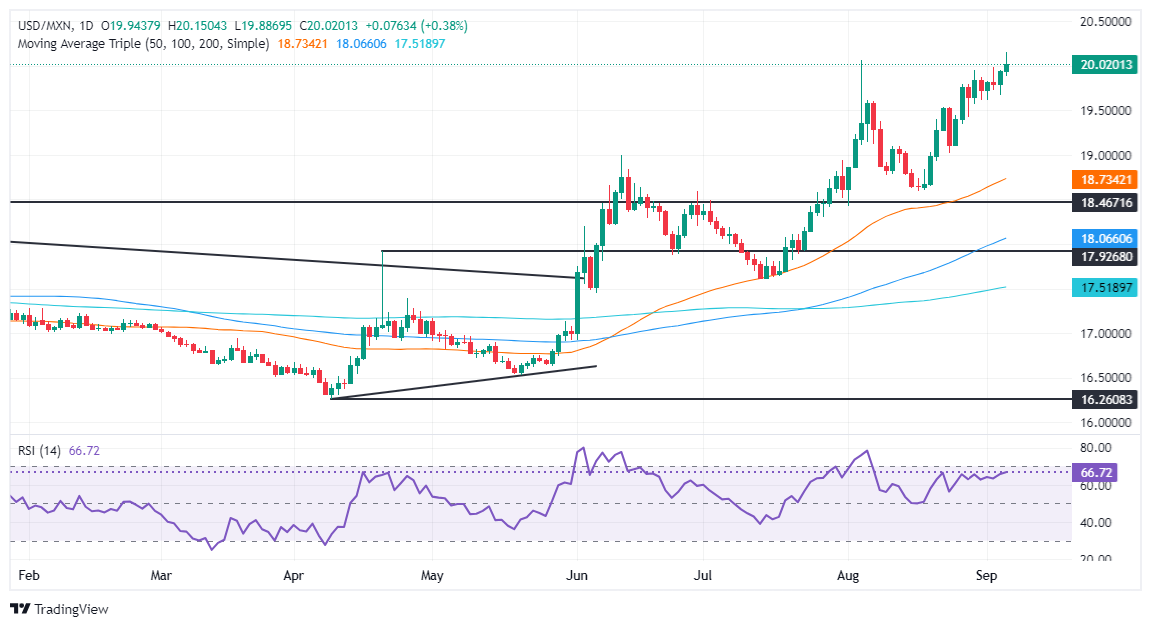- USD/MXN is up 0.20% at 19.97, hitting a four-week low of 20.14 amid political turmoil in Mexico.
- The judicial reform bill awaits Senate approval with potential implications for U.S.-Mexico relations and market sentiment.
- Upcoming inflation data from Mexico and US NFP are key factors that could influence the movement of the Peso.
The Mexican Peso fell against the Dollar during the New York session, hitting a four-week low of 20.14. Financial markets continued to digest the lower house’s decision to approve President Andrés Manuel López Obrador’s (AMLO) bill to make changes to the judicial system. The Peso extended its losses for the third consecutive day and finally broke the psychological barrier of 20.00 as traders began to dump the Mexican currency. USD/MXN is trading at 20.01, up 0.40%.
Mexico’s economic calendar is light, with investors awaiting the release of auto industry data on Friday. Next week, inflation figures will be in focus after the Bank of Mexico (Banxico) decided to cut borrowing costs despite revising its inflation projections upwards.
Back to political developments, two-thirds of the Senate must now approve the judicial reform bill. The ruling Morena party is one vote away, but if the bill is approved, it will be passed to 32 local congresses for approval. Once the bill is approved in 17 of those states, the changes to the Mexican Constitution will become official.
On Tuesday, U.S. Ambassador to Mexico Ken Salazar said the passage of the judicial reform could harm relations between Mexico and the United States.
Across the border, the US agenda has been busy with the release of employment data and services PMIs from the ISM and S&P Global. The ADP national employment change for August was disastrous, missing estimates and with a downward revision of the July figures.
Although the dollar weakened, it was a short-lived drop. Data released by the US Department of Labor showed that the number of Americans who filed for unemployment benefits was lower than expected.
According to the CME FedWatch tool, the probability of a 50 bp Fed rate cut is 39%, while the probability of a quarter-point rate cut is 61%.
Now that most of the data has been released, traders will now focus on the release of the Nonfarm Payrolls (NFP) report for August.
Daily Market Drivers Roundup: Mexican Peso Extends Losses Despite Mixed U.S. Data
- Data from Mexico released this week shows that the economy is slowing due to higher interest rates set by the Bank of Mexico.
- Most banks expect the Bank of Mexico (Banxico) to cut rates by at least 50 basis points (bp) for the rest of 2024. This would put pressure on the Mexican currency, which has depreciated 17.38% so far this year.
- The US ADP employment change for August fell from 111K to 99K, missing estimates of 145K. In contrast, initial jobless claims for the week ending August 31 fell from 232K to 227K, below the 230K expected.
- The ISM services PMI for August came in better than projected, rising to 51.5 from 51.4 in July, above consensus for a drop to 51.1.
- US Nonfarm Payrolls in August are expected to grow from 114K to 163K, while the unemployment rate is projected to decline from 4.3% to 4.2%.
- Data from the Chicago Board of Trade (CBOT) suggest the Fed will cut at least 104 basis points this year, up from 103 bps yesterday, based on the December 2024 federal funds rate futures contract.
Technical Outlook: Mexican Peso Weakens as USD/MXN Rises Above 20.00
Politics is the driving force behind the USD/MXN exchange rate. As traders digested the approval of the bill by the lower house, foreign investors were concerned about changes to the Mexican Constitution.
Therefore, the USD/MXN broke through the psychological barrier of 20.00 as buying momentum started to build up, as seen on the relative strength index (RSI). The RSI registered a new peak, and if the uptrend gains strength, it will put additional pressure on the Peso.
If USD/MXN breaks above the yearly high of 20.22, the next stop would be the daily high of September 28, 2022 at 20.57. If those two levels give up, the next stop would be the high of August 2, 2022 at 20.82, before reaching 21.00.
Conversely, if USD/MXN weakens further, the first support would be 19.50. A break of the latter will expose the August 23 low of 19.02 before giving way to sellers looking to test the 50-day simple moving average (SMA) at 18.65.
Mexican Peso FAQs
The Mexican Peso is the legal currency of Mexico. The MXN is the most traded currency in Latin America and the third most traded currency in the Americas. The Mexican Peso is the first currency in the world to use the $ sign, prior to the later use of the Dollar. The Mexican Peso or MXN is divided into 100 cents.
Banxico is the Bank of Mexico, the country’s central bank. Created in 1925, it provides the national currency, the MXN, and its primary objective is to preserve its value over time. In addition, the Bank of Mexico manages the country’s international reserves, acts as a lender of last resort to the banking sector, and provides economic and financial advice to the government. Banxico uses the tools and techniques of monetary policy to achieve its objective.
When inflation is high, the value of the Mexican Peso (MXN) tends to decrease. This implies an increase in the cost of living for Mexicans, which affects their ability to invest and save. In general, inflation affects the Mexican economy because Mexico imports a significant amount of final consumer products, such as gas, fuel, food, clothing, etc., and a large amount of production inputs. On the other hand, the higher the inflation and debt, the less attractive the country is for investors.
The exchange rate between the USD and the MXN affects imports and exports between the United States and Mexico, potentially affecting demand and trade flows. The price of the Dollar against the Mexican Peso is affected by factors such as monetary policy, interest rates, the consumer price index, economic growth and some geopolitical decisions.
The exchange rate between the USD and the MXN affects imports and exports between the United States and Mexico, potentially affecting demand and trade flows. The price of the Dollar against the Mexican Peso is affected by factors such as monetary policy, interest rates, the consumer price index, economic growth and some geopolitical decisions.
Source: Fx Street
I am Joshua Winder, a senior-level journalist and editor at World Stock Market. I specialize in covering news related to the stock market and economic trends. With more than 8 years of experience in this field, I have become an expert in financial reporting.








